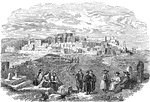
Chufa
Chufa is the edible tubers of cyperus esculentus. Chufas are eaten raw or baked. The plant is grass…

Cleome Spinosa
The common name of cleome spinosa is giant spider plant. The plant is clammy, strong scented, and grows…

Clethra Tomentosa
The common name of clethra is white adler. The tomentosa variety grows two to eight feet tall. It is…

Cranberry
Illustrated is the common cranberry, vaccinium macrocarpon. It grows wild only in North American. The…

Cypripedium Spectabile
Cypripedium spectabile is a stout plant. The flowers bloom in June. It is found from Maine, New England,…
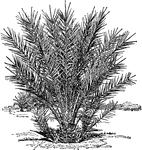
Young Date Palm
Illustrated is a young date palm with growing suckers or offshoots. It is native to North Africa and…
Belleville Dock
Illustrated is a leaf of belleville dock. It is a European and North American plant. It is really a…
Liatris Spicata Montana
Liatris spicata montana grows ten to twenty inches high. The flowers are blue purple. It is native to…

Greenhouse for Lettuce and Cucumber
Illustrated is a cross section of a greenhouse used for growing lettuce and cucumbers. The slanting…

Ligustrum Vulgare
The common name of ligustrum vulgare is common privet or prim. The shrub grows to fifteen feet. The…

Meadow Lily
Meadow lily and wild yellow lily are the common names of lilium canadense. It is the most common species…
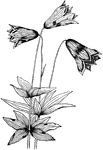
Lilium Grayi
Lilium grayi is native to North Carolina and Virginia. The flowers usually hang more loosely than how…

Linaria Bipartita
Linaria bipartita is native to Portugal and North Africa. The flowers are large and violet-purple.

Flowering Flax
Flowering flax is the common name of linum grandiflorum. It is native to North Africa. The plant grows…

Livistona Humilis
Livistona humilis is native to north Australia. The stems are four to sixteen feet high. The leaf stalk…
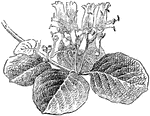
Lonicera Xylosteum
The lonicera xylosteum shrub grows ten feet tall. It is native to Europe and west and north Asia. The…

Lonicera Maackii
Lonicera maackii is an upright shrub that grows fifteen feet tall. Its growth ranges from north east…
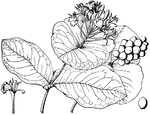
Lonicera Flava
The lonicera flava shrub climbs ten feet high. The flowers are orange-yellow and fragrant. It is native…

Ragged Robin
Ragged robin and cuckoo flower are the common names of lychnis flos-cuculi. The flowers are red or pink…
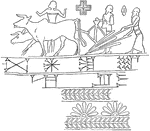
Babylonian Seal Impression
Pictured are men plowing a sowing. This illustration is from a Babylonian seal impression from the 14th…
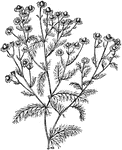
Wild Chamomile
Wild chamomile is the common name of matricaria chamomila. The flowers are white. The plant is found…
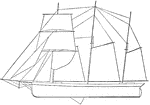
Wind-Powered Sailboat
First used by the Dutch in the 16th and 17th centuries and later refined in North America from the early…

Argentine Ant
Image of an Argentine ant. This destructive insect is native to parts of South America, but was accidentally…
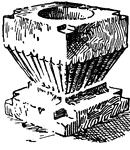
Baptismal Font at Lydbury North
This illustration shows the baptismal font at Lydbury North in England.
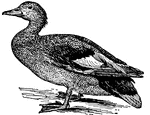
Gadwall Duck
The Gadwall (Chaulelasmus streperus) is a widely distributed duck, appearing throughout Europe and N.…

British Golden-rod
British Golden-rod is a member of the large composite genus Solidago, which is chiefly North American.…
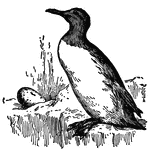
Common Guillemot
The Common Guillemot (Uria troile) is a member of the auk family. It breeds on all rocky coasts of the…
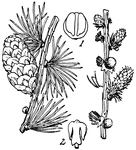
Larch, Cone and Flowers (male and female)
Larch, or Larix, is a genus of hardy, deciduous, coniferous trees of very graceful habit. They bear…

Human Leg (Front View), and Comparative Diagrams showing Modifications of the Leg
This illustration shows a human leg (front view), and comparative diagrams showing modifications of…

Leg of Seal
This illustration shows the leg of a seal. P. Pelvis, FE. Femur, TI. Tibia, FI. Fibula, TA. Tarsus,…

Lemming
A lemming is a small, yellowish-brown rodent, closely related to the vole, and belonging to the genus…

Turbo Generator
Sectional elevation of the 31,000 h.p. turbo generator units used in the Yadkin River development (North…

Alphabet of Antiquity
Leading alphabet of antiquity. Included is Punic (Western Semitic from Carthage, North Africa - now…

Coat of Arms
Coat of arms for the French Republic and Imperial Arms of France. France is the most western portion…

Phylloxera-mite
A phylloxera. Typically found in eastern North America, and related to the aphid, they typically feed…

The Town and Isthmus of Corinth
View of Ancient Corinth looking North. The Gulf of Corinth is at the left and the isthmus is center…

Puma
The puma, also known as the cougar, panther, or mountain lion (Felis concolor) , is a large American…

The Siege of Château Gaillard, the Saucy Castle of Richard the Lionheart - Aerial View
An aerial view of the siege of Château Gaillard, also called the Saucy Castle. Construction of the…

Prickly Saltwort
Salsola kali. This plant is also called a Russian Thistle, Prickly Glasswort, Tumbleweed, and Glasswort.…
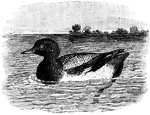
Scaup, a Common Duck
"A duck, Fuligula or Fulix marila and related species. The common scaup inhabits Europe, Asia, and North…
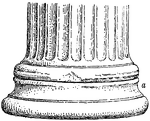
The Base of an Ionic Column at the Erechtheum
The base of the column, torus, displays a concave molding called a scotia. This type of base was not…

Elephant Seal on a Rock
"The seal Macrorhinus elephantinus or proboscideus, or Morunga proboscidea. It is the largest of the…

Seal Swimming up to an Igloo
Illustration of the entrance of an igloo, built out of ice, partially underwater. A seal is swimming…

Leopard Seal
Leptonychotes weddelli. "A spotted seal of the southern and antarctic seas, belonging to the family…

Seal Press
"A press or stamp bearing dies on its jaws, or a die and a bed, for imprinting or embossing any device…

Skippet - Open Box with a Seal Inside
"A circular box used for covering and protecting a seal. Old documents were commonly sealed by means…
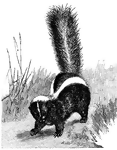
Common Skunk
"A fetid animal of the American genus Mephitis, M. mephitica... The animal inhabits all of temperate…
Seneca Snakeroot - Stem and Flowers
"Polygala senega of eastern North America. It sends up several stems from hard knotty root-stocks, bearing…

Seneca Snakeroot - the Fruit
"Polygala senega of eastern North America. It sends up several stems from hard knotty root-stocks, bearing…

Seneca Snakeroot - Roots and Base of the Stem
"Polygala senega of eastern North America. It sends up several stems from hard knotty root-stocks, bearing…

Sparada
"An embiotocoid fish of the Pacific coast of North America, Micrometrus aggregatus; a name also extended…
White Marlin, a Sailfish
Tetrapturus albidus. Also called a billfish or spearfish, "the dorsal fin is low or moderately developed,…
